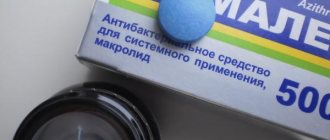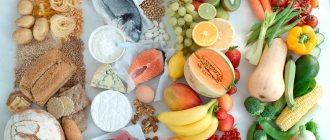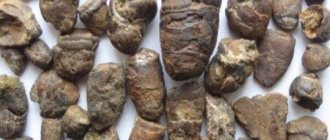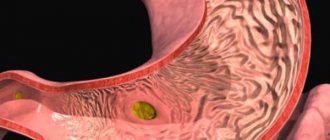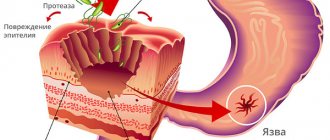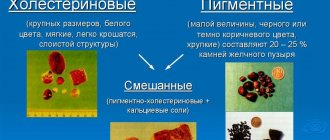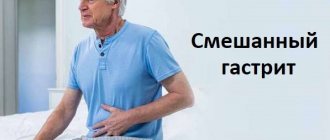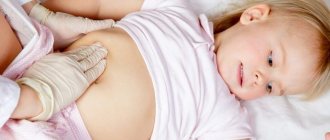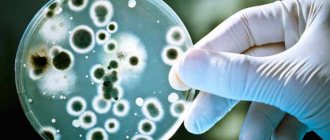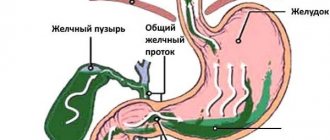Causes of inflammation
The causes of inflammation of the gallbladder are quite varied and depend on the development of pathological processes in the organ:
- biliary dyskinesia (impaired normal flow of bile);
- the formation of stones in the organ that clog the ducts and the sphincter of Oddi that regulates the flow
- bile into the stomach;
- bending of the gallbladder, its deformation, which is congenital or acquired;
- oncological processes in the body (formation of malignant tumors, metastases);
- diseases of an inflammatory nature (hepatitis accompanied by inflammation of the liver, cholecystitis, characterized by acute processes in the gallbladder and its ducts);
- infectious diseases (viral hepatitis A, B, C, D, E, hepatic tuberculosis, amebiosis, giardiasis, opisthorchiasis, intestinal and liver damage by parasites);
- alcohol intoxication, poisoning of the body with poisons and toxins;
- long-term use of medications (hormones, antibiotics, sulfonamides, painkillers);
- benign tumors (polyps, cysts).
Description of the problem
The most common gallbladder diseases are:
- biliary dyskinesia;
- cholecystitis;
- gallstones.
The gallbladder performs the following main functions:
- thickening of bile;
- regulation of bile secretion;
- neurohumoral regulation.
Symptoms of an unhealthy gallbladder:
- bitter taste in the mouth;
- yellow coating on the tongue;
- headache, which is localized in the temple area;
- nausea;
- pain in the knee joint, most often in the right;
- pain in the gallbladder, radiating to the right hypochondrium;
- motion sickness on public transport;
- excessive irritability, anger;
- pain under the right shoulder blade.
The main manifestations of dyskinesia are:
- Aching, dull pain in the right hypochondrium. They usually appear 15-30 minutes after eating and can last from a few minutes to several hours. And sometimes the pain becomes constant.
- Constant weakness, irritability, sleep disturbances.
- Loss of appetite. In some patients it sharply decreases, while in others it increases.
If dyskinesia is not treated, then over time it can cause inflammation of the gallbladder, which is called cholecystitis. It happens:
- calculous, that is, accompanied by the formation of stones;
- non-calculous (without stones).
Non-lithiasis cholecystitis is manifested by pronounced and severe pain in the right hypochondrium. They can appear, for example, when shaking in a car. The pain becomes more intense if cholecystitis is accompanied by an infection.
The following diagnostic methods are used:
- Ultrasound;
- Abdominal CT scan;
- probing of the gallbladder, which helps determine the composition of bile;
- a blood test that will show if liver dysfunction has occurred and will help adjust treatment.
Untreated liver and gallbladder diseases also provoke the development of pancreatitis. It makes no sense to treat pancreatitis locally. Complex therapy is necessary, which should begin with getting rid of gallstone problems.
Dysfunction of the gallbladder leads to the development of an inflammatory process in the intestine, and its microflora is disrupted. Parasites can multiply in the intestines, which is manifested by bloating and flatulence.
Gallbladder diseases occur due to excessive secretion of bile or, conversely, its stagnation.
The main factors that provoke the accumulation of bile in the gallbladder and its diseases are:
- poisoning, including alcoholic;
- excessive negative emotions such as anger;
- constant stressful situations at work;
- poor nutrition, excess meat dishes in the diet;
- helminth infection, such as opisthorchiasis;
- consequences of surgery
- sedentary lifestyle.
Of course, a healthy diet is very important, but problems mainly arise due to stress and lack of physical activity.
Modern people move little and mostly sit in offices at the computer. The abdominal area must be massaged for the health of its internal organs. In our case, to stimulate the gallbladder so that bile does not stagnate.
But still, the main problem of bile stagnation is the frequent manifestation of negative emotions. Worried about something, nervous, we unconsciously compress the muscles of the internal organs, in our case the sphincter of Oddi, as a result we do not allow bile to exit normally from the gallbladder. Negative emotions are especially destructive during meals, at the moment when bile begins to be released.
Let us now consider how to treat chronic inflammation of the gallbladder.
Very often, the patient experiences the first pain a few hours after a heavy feast. Fried and fatty foods, starting with lard and ending with various kinds of smoked meats, can provoke an attack. The stone leaves its usual habitat and, penetrating the duct, clogs the bile flow, as a result of which the bladder begins to become inflamed (inflammation of the gallbladder). Cutting pain.
Click here - all materials about cholecystitis
All materials about cholecystitis at the link above
The development of the clinical picture begins with pain in the area of the right hypochondrium. In this case, the pain tends to radiate to various parts of the body. Nausea may be present, leading to vomiting, as well as belching. The temperature may rise significantly at this time, and in some cases jaundice of the skin appears.
Symptoms of cholecystitis
Rarely, cholecystitis is characterized by a latent course.
In such a situation, the patient complains of almost nothing, and the pathology is detected by chance during the examination. As a rule, most symptoms in adults develop after certain holiday events, stressful situations, bumpy driving, or excessive exercise.
The existing symptoms of a painful condition in adults are combined into the following syndromes:
- Painful. Pain of various types, most often detected under the ribs on the right, radiates to the right shoulder, neck and shoulder blades.
- Dyspeptic. Manifested by flatulence, nausea, vomiting, constipation or diarrhea.
- Intoxicating. Characterized by hyperthermia, malaise, and lack of appetite.
- Syndrome of autonomic changes. The patient complains of headaches and increased sweating.
Diagnostic methods
The main symptom of cholecystitis is pain in the right hypochondrium, and occasionally under the sternum. It can radiate to the scapula and collarbone on the right, shoulder and shoulder joint, sometimes to the hypochondrium on the left and to the region of the heart. More often the pain is prolonged and aching, but an attack of cholecystitis can be accompanied by unbearable acute spasms.
Patients suffer from nausea, heartburn and belching, and it is not uncommon for cholecystitis to experience bitterness and dry mouth, bloating in the abdomen and upset stool. Severe attacks with cholestasis are usually accompanied by vomiting, often with an admixture of bile. These symptoms often occur against a background of moderately elevated body temperature, malaise and weakness, and sometimes jaundice of the sclera and skin is noted.
Treatment of chronic cholecystitis is usually carried out with conservative methods (but surgery may also be required).
Among its main goals:
- elimination of inflammatory changes in the wall of the gallbladder;
- prevention of complications;
- elimination of symptoms of pathology;
- improving the quality of life and rehabilitation of patients.
It is important to reduce the number of exacerbations
Before we look at what medications to take for cholecystitis, we would like to draw your attention to the fact that diet therapy remains an important method of treatment. All patients with XX should adhere to treatment table No. 5 (according to Pevzner).
Among its principles:
- Frequent and, importantly, small meals (about 5-6 times a day).
- Creating and maintaining a clear diet.
- Consume 2500-2900 kcal per day.
- Creating a menu with the optimal content of proteins, fats and carbohydrates.
- Reducing the proportion of animal fats in the diet and increasing the proportion of plant fats.
- Drink plenty of fluids (about 2 liters of clean water per day).
- The preferred heat treatment options are boiling and steaming.
We treat the body from the inside
Among the permitted products:
- lean meat (poultry, rabbit, beef, fish);
- wheat bran;
- cereals (especially millet, buckwheat);
- fermented milk products;
- vegetables and fruits.
In addition to water, it is useful to drink dried fruit compotes and rosehip decoction.
The following are excluded from the diet of patients:
- fatty, smoked dishes;
- fatty meat and offal (kidneys, brains, tongue, etc.);
- egg yolks;
- spices and seasonings;
- rich broths;
- baked goods and confectionery products;
- nuts;
- alcohol;
- carbonated drinks.
Permitted and prohibited products
Medicines for cholecystitis of the gallbladder are another mandatory element of therapy. It is very important that all tablets and injections are prescribed by a qualified doctor (generalist or gastroenterologist) based on the examination data obtained. Only a specialist will be able to assess the nuances of the pathology and the individual characteristics of the body.
What medications will be helpful for you?
So, what to take for cholecystitis: medications are divided into several pharmacological groups.
| Group | Mechanism of action | Representatives |
| Antibiotics | Elimination of bacterial infections and local inflammation | Azithromycin, Ampicillin, Amoxicillin, Ceftriaxone, Metronidazole |
| Sulfonamides | Destruction of pathogenic microorganisms in the intestines (with concomitant inflammation) | Sulfadimezin, Sulfalene |
| Antimycotics | Destruction of fungi that can rapidly multiply in the gastrointestinal tract in response to antimicrobial therapy | Nystatin, Fluconazole, Furazolidone |
| Choleretic drugs | Normalization of bile production and outflow | Allohol, Holosas, Chofitol |
| Antispasmodics | Relieving muscle spasms, eliminating pain syndrome | No-shpa, Papaverine, Trimedat, Duspatalin |
| Hepatoprotectors | Restoration of liver function, acceleration of hepatocyte regeneration | Essliver, Essentiale forte, Ursosan, Karsil, Heptral |
To diagnose various diseases of the gallbladder, specialists prescribe a certain number of studies:
- palpation of the painful area;
- a general blood test to determine the degree of the inflammatory process;
- urine biochemistry to assess the functioning of the gallbladder;
- Ultrasound of the abdominal organs;
- coprogram (stool examination to study the digestion process);
- probing, bacteriological culture;
- analysis of bile for chemical indicators;
- CT scan;
- performing a biopsy;
- Cholangiography.
If you go to the hospital in a timely manner and make an accurate diagnosis, you can avoid long-term treatment and correct dietary errors by following a certain diet.
It is known that treatment of liver and gall diseases using official medicine methods rarely gives a lasting positive effect. Often this even contributes to the deterioration of the patient’s well-being. And when a person gets to a normal specialist, the process is already very advanced, and it is very difficult to cure such a patient.
If the gallbladder is inflamed, then an alternative medicine specialist or visceral therapist can suggest ways to treat it at home. They will expertly approach the solution of the problem, prescribing competent treatment.
If you decide to treat yourself, then you need to listen to yourself in order to understand the reason for the development of the disease. It can lie in the lifestyle and emotions that the patient experiences. By determining the root cause of the problem, you can understand how best to treat bile stagnation in the gallbladder.
You should start working on yourself by adjusting your diet, reducing your consumption of meat and fatty foods. Finally start moving, play sports. Special exercises, which will be discussed below, will also help you.
Emotional control is also very important. If you constantly experience negative emotions, you will never cope with the disease. Remember that they create muscle spasm, which prevents bile from flowing out normally. You can read how to learn to manage your emotions in a separate article. First of all, you also need to learn to relax while lying down, imagining how a spasm is released inside the abdomen, blocking the release of bile.
All this can be supported by taking herbs. The following plants and their components are considered especially effective for diseases of the gallbladder:
- black radish juice;
- immortelle herb;
- juice from milk thistle grass and oil from its seeds;
- tansy herb, known for its antiparasitic properties;
- pumpkin and juice from it.
All of the listed plants can be easily found in a pharmacy or market.
It is also useful to take a tablespoon of extra virgin olive oil once a day on an empty stomach.
To eliminate congestion in the gallbladder, you need to undergo a course of visceral massage from a qualified specialist. But you can learn how to massage yourself. There's nothing complicated about it. Watch this video. When gallstones form, surgery is often prescribed. But there are also non-surgical ways to remove them, for example, using visceral therapy and Chinese medicine.
But even after surgery, when the stones have been removed, there is no guarantee that they will not form again. If the gallstone has been removed, the stones may appear in another organ, for example, in the hepatic ducts, from where it will be impossible to remove them.
Everything must be done to prevent the removal of the gallbladder. After all, after this, the patient often develops chronic diarrhea, or, conversely, chronic constipation, as well as other problems. Surgical intervention provokes adhesions in the tissues that were cut. As a result, the organs in the abdominal cavity are displaced.
Signs of gallstone disease
The goal of any diet should be to improve health, but preventing the gallbladder from emptying with a low-fat diet may do more harm than good, although such a diet (proper diet and eating habits) before and after surgery is desirable because it allows the bladder to remain unstrained.
Typically, patients with cholelithiasis, bile duct obstruction and gallbladder disease are recommended to eat a diet with 25% fat (calorie content). Completely low-fat foods should be avoided as they interfere with the absorption of essential fatty acids, carotene, and essential vitamins A, D, E and K and create their deficiency.
When hepatitis, pancreatitis, or a stone first blocks the bile duct, nausea and vomiting prevent the patient from eating. In this case, you should immediately call a doctor and make every effort to prevent acidolysis and meet the body's need for nutrients during stress.
At the end of the acute stage, meals at two-hour intervals are gradually replaced by six meals a day. In most gallbladder diseases, there is a lack of bile, but additional intake of leditin helps homogenize fats and improve their absorption. Although the production of bile acids, necessary for the transport of digested fats and fat-soluble essential vitamins through the intestinal wall, can be doubled when using vegetable oil instead of solid fat, they (bile acids) should temporarily be taken in tablets (dried bile).
Typically, a teaspoon of lecithin and 1-3 tablets of dry bile with enzymes with each meal is enough to ensure effective digestion and prevent flatulence. Soft stools indicate that enough bile has been taken in and insoluble soaps are not formed. Since the levels of essential vitamins A, D and E in the blood are especially low in cases of gallbladder disease, these fat-soluble vitamins should be taken with lecithin and bile.
It can be alleviated by eating 1-2 cups of yogurt or acidophilus per day (day). If the strong odor of the stool persists, indicating incomplete digestion of protein, the amount of lecithin, yogurt or acidophilus and bile tablets with enzymes should be increased; conversely, if there are no digestive problems, you can stop taking the pills.
as a rule, it contains a long list of prohibitions that, as it turns out, have no scientific basis. In fact, no product should be neglected if it promotes health. Even salads are not taboo. To stimulate the flow of bile, it is good to take at least a teaspoon of vegetable oil with each meal, and add seasonings for appetite.
First, as a rule, milk and fermented milk soups, whole grain bread and cereals, lean meat and fish, eggs, cottage cheese, fruits, vegetables, sweet milk cream and other fermented milk desserts are allowed. If your weight allows and recovery is successful, you can eat small portions of pork, beef, quite a bit of fried food, provided you take lecithin and bile tablets with each meal.
Since vegetable oil is digested much easier than solid fats and, in addition, increases the production of bile acids and lecithin and reduces the cholesterol content in bile, it should be used for cooking. Every day (day) it is useful to eat several eggs or egg yolks, especially if the liver is damaged.
To get the high-protein foods you need for recovery without gaining excess fat, it is much better to rely on yeast, soy flour, wheat bran, fresh and powdered skim milk, nuts, non-hydrogenated nut butters, and liver lightly fried in vegetable oil. Many of these products can be included in breads, pies, pancakes and cakes.
There are a number of signs that can be seen.
- Yellowing: Yellowing of specific areas of the skin. Clogged channels, and the mixing of bile acid with blood contributes to its deposition on tissues.
- Colic caused by the movement of pebbles in the canals.
- Vomiting sensations, regular belching of air, and heaviness in the stomach.
- Unpleasant taste in the mouth.
- Nausea, vomiting (sometimes with bile), after which a feeling of relief usually does not occur.
- Yellowness of the skin, sclera of the eyes, mucous membranes of the mouth (jaundice).
- Bloating, constipation, diarrhea.
- General weakness and malaise.
When drawing up a menu for the treatment of the gallbladder, it is necessary to consult with a specialist. A sample menu may look like this: • 1st breakfast: low-fat cottage cheese with dried apricots or prunes, buckwheat porridge and tea. • 2nd breakfast: baked apple (no sugar). • Lunch: Vegetable soup, noodles with boiled meat, berry jelly. • Afternoon snack: tea with oatmeal cookies. • Dinner: vegetable salad, mashed potatoes with fish (steamed); • Before bed: a glass of kefir.
Treatment of diseases of this organ with traditional methods can be very effective. But, only if the diagnosis is accurately confirmed by specialists.
The flowers of this plant, the most popular in folk medicine, are collected two weeks after the start of flowering and dried. For a glass of boiling water you need 10-15 g of dried immortelle flowers.
Moreover, the stems, roots and color of this plant can be used for this purpose. They are dried and crushed. A decoction of chicory is prepared as follows. Take two tablespoons of the prepared mixture and pour in 500 ml of boiling water. For a better effect, you can cook the broth for another 5 minutes, strain and add honey to it. This decoction can be drunk instead of tea or coffee twice a day.
Recipes for infusions, decoctions and other remedies based on them can be found in other articles on our website.
Herbs and spices on a wooden background
Contraindications to gallbladder cleansing
Cleansing the gallbladder for therapeutic and preventive purposes is recommended 1–2 times over 12 months. This technique allows you to prevent stagnation of bile, and preliminary preparation (following a diet, taking herbal teas, teas) provides positive results. [ads-pc-2] 7 days before the procedure, you must switch to fractional meals, following some recommendations:
- eating boiled or steamed food;
- consumption of lean meats (rabbit, turkey, chicken, young veal);
- low-fat fish (pike perch, pollock, hake);
- fermented milk products (cottage cheese, sour cream, fermented baked milk);
- fruits and vegetables in small quantities;
- recommended consumption of freshly squeezed orange and beet juice;
- cereal porridge, whole grain bread.
Before directly cleaning the organ, it is important to consider the presence of possible contraindications:
- progression of infectious diseases in the body (pneumonia, FLU, ARVI, gastroenteritis);
- functional disorder of the gastrointestinal tract (nausea, vomiting, diarrhea, constipation);
- diseases of the digestive system of a chronic nature (pancreatitis, cholecystitis, duodenitis, gastritis, hepatitis);
- period of pregnancy and breastfeeding;
- infection of the intestines and stomach by various parasites;
- exhaustion at the psychological and physiological level;
- recovery period after operations on the gastrointestinal tract;
- cardiac pathologies (stroke, thrombosis, myocardial infarction, hypertension, angina pectoris);
- development of malignant tumors in the body;
- mental disorders with acute symptoms;
- stones in the gallbladder and its ducts.
Cleaning the gallbladder is a fairly effective procedure that requires compliance with all prescribed recommendations and should be carried out only if there are appropriate indications. The advantages of manipulation are based on safety for the body and ease of implementation.
Drug therapy
How to treat with oral agents in each case is determined by the diagnosed pathology. Painful sensations are relieved with antispasmodics and analgesics. Stagnation of bile is eliminated by choleretics; if stones appear, at an early stage, cholelitholytics can be prescribed.
Sorbents are used to remove toxins, and if damage to the mucous membrane is caused by a bacterial infection or parasitic infestation, antibiotics and anthelmintics are used. How to treat and what medications to take can only be determined by the attending physician.
Often, drug therapy for the gallbladder includes drugs that optimize the activity of the hepatobiliary system and digestive organs.
Folk recipes
These methods, proven and reliable, have helped patients for centuries to successfully cope with numerous symptoms of cholecystitis and relieve inflammation. However, it is necessary to consult with your doctor before using them. Decoctions and infusions of many herbs and fruits help relieve heaviness in the hypochondrium, dryness and bitterness in the mouth, for example:
- a tablespoon of dried corn silk poured into a glass of boiling water and infused for an hour is filtered and taken a quarter glass before meals;
- pour a liter of boiling water and infuse for 24 hours a glass of freshly ground horseradish root, strain it and drink 1/4 glass before meals until the painful symptoms disappear;
- a tablespoon of finely chopped parsley infused in a glass of boiling water is taken warm, 1/4 cup before meals;
- Rose hips, brewed according to the instructions, can successfully replace tea for people with cholecystitis.
Natural remedies for cholecystitis that have been proven for centuries are also vegetable oils that promote the outflow of bile - olive, sunflower, sea buckthorn, as well as the leaves and stems of peppermint, the color of immortelle.
Treatment of cholecystitis requires a responsible approach and serious attitude. In any case, it must be monitored by the attending doctor; self-medication is fraught with unpredictable consequences and unforeseen complications. Consultation with a doctor will allow you to decide how to treat a particular patient and will allow you to develop a long-term individual treatment plan that is adequate to the age, constitutional characteristics of the patient, as well as the nature, severity and phase of disease activity.
Let's look at how non-calculous cholecystitis is treated with folk remedies. The collections presented below have analgesic, anti-inflammatory, sedative and choleretic effects.
A decoction is prepared from buckthorn bark, cumin fruits and mint leaves, mixed in a ratio of 2:1:2. A tablespoon of the mixture is poured into a glass of boiling water. Drink a glass of the product at night for 2-3 months.
If there is stagnation of bile in the gallbladder, then treatment is carried out using the following collection:
- Mix chamomile flowers, immortelle flowers and sage leaves in equal parts.
- Take a tablespoon of the mixture and pour a glass of water.
- Boil for 20 minutes over low heat and let it brew.
Take the composition 2-3 times a day.
Complex treatment of inflammation and dyskinesia of the biliary tract includes taking decoctions of gentian yellow, dandelion roots, and chicory. These plants contain bitters that stimulate the production of bile and gastric juice.
The roots of any of the above plants are dried and crushed. The raw materials are placed in an enamel container and filled with hot boiled water in a ratio of 1:10. Then the composition is infused in a water bath for half an hour, after which it is cooled for a quarter of an hour. The prepared broth is filtered and squeezed. Remedies containing bitterness, take a quarter glass 30 minutes before meals.
When diagnosed with inflammation of the gallbladder - cholecystitis, treatment can be carried out using the following infusion:
- Dried immortelle and tansy flowers are mixed with corn silk.
- Take a tablespoon of raw material and place it in an enamel bowl.
- Pour the raw material with a glass of water.
- Place the container on the stove and boil for a quarter of an hour.
- Then cool for 45 minutes, strain and squeeze.
- Bring the infusion to its original volume by adding boiled water.
The product is taken 1 tablespoon 5-6 times a day. Young children and pregnant women should not drink the infusion.
How to clean your gallbladder at home
To eliminate congestion in the gallbladder, folk remedies, medicinal herbs, various combinations of products, and physiotherapy procedures are used. When choosing the appropriate method, the presence of chronic diseases, allergies, and individual intolerances is taken into account.
The cooking recipe is based on pouring 40–50 grams of dried plant flowers with 1 liter of boiling water. The resulting solution is infused for 2 hours. The finished product is taken 100-150 ml 3 times a day before meals. The duration of treatment is 10–15 days.
After completing the course, stage 2 of cleaning begins. Next, mix lemon juice and olive oil in equal proportions. The resulting product is drunk on an empty stomach and kept at rest for 60 minutes.
The next day, a cleansing enema is performed to remove toxins and waste from the body. It is recommended to undergo therapeutic fasting with drinking at least 2 liters of drink (water with lemon juice and a small amount of honey) throughout the day.
After 3 days of cleansing, boiled vegetables begin to be gradually introduced into the diet.
Tubage is a procedure that is based on washing and cleaning internal organs and requires the following recommendations:
- Carrying out the procedure in the morning on an empty stomach;
- before taking the treatment solution, take a glass of mineral alkaline water without gas;
- the total amount of liquid for consumption should not exceed more than 500 ml (including the medicinal decoction);
- Before cleaning, it is recommended to take an anesthetic (No-shpa) to eliminate negative sensations;
- to dilute stagnant bile, take sunflower oil heated to a temperature of 38 C; bed rest for 2–3 hours and applying a heating pad to the organ to dilate the ducts, eliminate spasms, pain, and accelerate the evacuation of bile.
Beet juice
To carry out the procedure, 600 ml of freshly squeezed juice is obtained from beets, which is boiled over low heat for 10–15 minutes. The finished product is divided into 3 doses and taken 200 ml throughout the day.
Intensifying the effect obtained requires applying a heating pad to the organ site and maintaining bed rest for 2–2.5 hours. After consultation with the attending physician, cleaning should be carried out on a day off, since beets have a pronounced diuretic effect.
- performing an enema in the morning;
- following a diet throughout the day (taking juices, fruits, vegetables, excluding fatty, high-calorie foods);
- taking 1 glass of cognac (40–50 ml) and castor oil in the same amount after 30 minutes;
- if attacks of nausea occur, then use small slices of lemon;
- refusal to eat and drinking non-carbonated purified water;
- a sign of the procedure being a frequent urge to go to the toilet;
- On the second day, you can gradually introduce fruits (apples) into your diet.
Choleretic herbs
To eliminate severe stagnation of bile, decoctions of choleretic herbs (buckthorn, watch, dandelion, wormwood, steelwort, St. John's wort, immortelle) are also used. Calendula, ginseng, and aloe are used to increase the functionality of the organ ducts.
A good effect is obtained by taking choleretic infusions from the fruits of coriander, mint, immortelle, and yarrow.
How to get rid of cholecystitis
Therapy depends on the type of cholecystitis and its severity. Exacerbation of pathology is an indication for hospital stay. With chronic variants, patients with mild and uncomplicated forms without intense pain syndrome can be treated on an outpatient basis.
When treating cholecystitis, certain rules must be followed:
- Stick to a diet
If there is an exacerbation, drink weakly brewed tea, mineral water without carbon, juices and fruit drinks consumed are diluted with water by half. Pureeed soups and porridges, low-fat cottage cheese, steamed meat and fish are allowed. After a week, they switch to a physiological diet.
Products are consumed every 3 hours in small portions. This does not aggravate the inflammatory process in the bladder and reduces pain.
Prohibited: foods with excess fat content, fried, smoked, spicy seasonings.
- Medicines
Medicines help relieve pain during exacerbation. These include:
- No-Shpa. Take 2 tablets three times a day.
- Papaverine. Most believe that the medicine in suppositories is more effective than the tablet form.
- Duspatalin. To eliminate clinical symptoms in adults, it is enough to take 1 tablet twice a day, half an hour before meals.
- Oxafenamide. Persons who have reached the age of majority are prescribed a dosage of 1-2 tablets 3 times a day.
Duration of therapy is about 3 weeks. An increase in the duration of treatment is allowed.
Advice from Dr. Evdokimenko
Dr. Evdokimenko explains well how to prevent and treat chronic cholecystitis. His opinion coincides with what was said. The main factors influencing the development of gallbladder diseases are:
- poor nutrition;
- sedentary lifestyle, causing bile stagnation;
- stress causing compression of the biliary sphincter, resulting in stagnation of bile.
In order to prevent the development of pathology and prevent its development, you need to:
- start moving;
- eat rationally;
- avoid stress.
Be sure to watch this video. A competent gastroenterologist will tell you how to effectively treat acalculous cholecystitis. Even though traditional medicine will not cure you completely, you still need to see a doctor. He will prescribe a diet that will not be very strict. It is necessary to eat 4-5 times a day in small portions, excluding snacks between meals.
The diet prohibits:
- hot dishes and drinks;
- meat, fish and mushroom broths;
- fatty fish and meat;
- smoked meats and semi-finished products;
- pancakes and pancakes;
- cocoa, chocolate ice cream;
- sour apples;
- alcoholic drinks.
Medicinal herbs for cholecystitis and pancreatitis treat the pancreas and gall. These include:
- corn silk;
- milk thistle;
- dandelion root;
- burdock root.
These herbs restore gall tissue and normalize the functioning of the pancreas. Plants are used in the form of decoctions and infusions.
The following herbs are most effective for gallstones:
- immortelle;
- yarrow;
- calendula.
Calendula is also very beneficial for the stomach.
Many people wonder how to treat gallstones if there is no money. Evdokimenko recommends such a budget drug as Rovachol. Indications for its use are:
- cholecystitis
- dyskinesia;
- atonic constipation;
- removal of gall.
Contraindications to Rovachol are:
- hypersensitivity to the components of the drug;
- presence of gallstones;
- acute hepatitis;
- ulcers of the stomach and duodenum;
- acute pancreatitis.
The antimicrobial drug Trichopolum or Metronidazole is also used.
How else to cure cholecystitis forever? Apply the tips above, plus add specific exercises. There are 5 effective exercises for pancreatitis and cholecystitis. But they cannot be done if there are very large stones in the gallstones, as blockage of the ducts may occur. We'll talk about these exercises another time.
In addition, the use of mineral waters, such as Essentuki No. 4 and 17, water from Zheleznovodsk and Truskavets, helps restore the functioning of the gall bladder. They are used for cholecystitis and pancreatitis. You can drink water only after all the gas has come out of it. Also, the water should be at room temperature. The course of treatment is 3-4 weeks.
It is very important not to start the process and start therapy on time. The answer to the question whether chronic cholecystitis can be cured depends entirely on how early treatment is started. In order to get rid of gallstone problems, visceral massage, folk recipes, diet, special exercises, and an active lifestyle are used. It is important to promptly eliminate stress, which is one of the main factors that provoke this disease.
That's all for today.
Don't get sick, be healthy.
Now just relax listening to this beautiful melody.
Nutritional Features
It is very important to maintain proper nutrition in treating the disease. The diet consists of the following principles:
- low-fat fermented milk products;
- light soups;
- boiled and raw vegetables;
- fruits and berries, but not sour ones;
- yesterday's bread;
- pasta;
- weak tea, compote.
The following foods are not allowed: marinades, smoked, fatty, fried foods, sour fruits and vegetables, fresh bread, spices and spicy foods, fast food, alcohol and coffee.
This diet is mandatory during the treatment of an attack of the disease. It can be used to treat cholecystitis at home. Additional recommendations from doctors include:
Include plenty of raw vegetables in your menu
- avoid overeating;
- cope with stress;
- do not lose weight suddenly;
- include a large amount of fresh vegetables in the menu;
- refuse, minimize the presence of alcoholic beverages and coffee.
